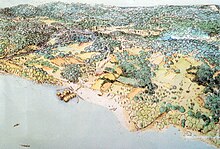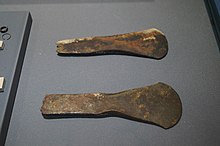Moniga del Garda stilt house settlement
Coordinates: 45 ° 31 ′ 13 ″ N , 10 ° 32 ′ 17 ″ E
The pile dwelling settlement of Moniga del Garda ( Italian: Palafitta di Moniga del Garda ) was a Bronze Age lakeside settlement on Lake Garda in the area of the Italian municipality of Moniga del Garda . It is an associated station of the 111 prehistoric pile dwellings around the Alps , which were added to the list of UNESCO World Heritage in 2011.
exploration
In 1979 the discovery of stakes in the port of Moniga del Garda was reported. As it turned out, the site had been known to amateur researchers for a long time. To prevent robbery excavations , the archaeologist Gabriella Enrica Pia carried out systematic investigations in the southern part of the marina in May 1981 . In October 1984 police confiscated 750 artifacts from recreational diver A. Garro that he had illegally recovered during his dives. About 40 finds came from the pile dwelling settlement of Moniga.
description
The field of upright piles on which the pile dwelling settlement rested had a size of 400 by 180 m. The settlement was located about 60 m from today's bank, as the water level in the Bronze Age was about 5 m lower. The wave movement eroded the ends of the posts and scraped off the surface of the ceramic shards. Based on the findings, the use of the settlement can be dated from the Middle Early to the Middle Bronze Age (2200–1550 BC). The settlement is assigned to the Polada culture of northern Italy .
Cultivated wheat and collected fruits such as cornel cherry , common hazel , wild apple , blackberries and strawberries could be identified as vegetable food . The found bones showed that residents of cattle , pigs , sheep and goats held and wild boar and deer hunting. They made sickle blades and arrowheads from local flint . A terracotta melting pot and blower nozzle show that metal was processed on site. Among other things, a bowl with a cross symbol in the Barche di Solferino style from the end of the Early Bronze Age ( Bronzo Antico II ) and an Isolone del Mincio cup from the Middle Bronze Age were discovered. There were also goblets from the last phase of the Early Bronze Age, bowls with an angular profile that imitated metal vessels, and two spindles. On bronze objects one found needles, three axes with raised edges, four sticks, four dagger blades and a spear point with a flamed blade.
A. Garro's finds also included two loaf of bread . One is made of terracotta and is 3.5 cm high and 1.85 cm wide. It has a rectangular shape and a round cross section. There are five grooves on both sides and a small triangle is stamped on three grooves on one side and one groove on the other. The other idol is made of stone, is 3.9 cm high and 2.2 cm wide. It is oval with a biconvex cross-section and has two grooves on both sides. A hole above the grooves suggests that the idol was worn as a talisman around the neck. The finds are in the Museo Civico "Giovanni Rambotti" in Desenzano del Garda .
literature
- Raffaele Carlo de Marinis: Due nuove tavolette enigmatiche dalla palafitta di Moniga del Garda (BS). In: Istituto Italiano di Preistoria e Protostoria (ed.): Atti della LII Riunione Scientifica dell'IIPP, Preistoria e Protostoria in Lombardia e Canton Ticino. Istituto italiano di preistoria e protostoria, Convegno: Preistoria e protostoria in Lombardia e Canton Ticino, 17–21 ottobre 2017, p. 213. Only published as PDF (2.4 MB).
Web links
Individual evidence
- ^ Raffaele Carlo de Marinis: Due nuove tavolette enigmatiche dalla palafitta di Moniga del Garda (BS). P. 213.
- ↑ Alessandro Facchin: Tipocronologia dei manufatti nei corredi funerari dal neolitico all'antica età del bronzo in Italia settentrionale. Università degli Studi di Padova, p. 195 ( online ; PDF; 55.8 MB)
- ↑ Raffaele Carlo de Marinis: L'età del Bronzo nelle palafitte del lago di Varese in Alle origini di Varese e del suo territorio , Rome 2009, ISBN 978-88-8265-516-7 , p. 130 ( online )

